The pixel size on the screen and the number of pixels per square centimeter are always different depending on the matrix of the screen. There is a special value - pixels per inch (ppi). From it, you can calculate the number of pixels per mm and cm and vice versa, in a given distance of pixels.
Instructions
Pixel is not a metric or static value. This is a relative value. Therefore, to calculate the number of pixels in a centimeter, you need to know such a parameter as ppi. It should be noted that the human eye does not distinguish ppi equal to 306 or more. These are such small pixels that the eyeball cannot recognize a single point and perceives the image as a whole. Today, this ppi parameter is used when printing glossy magazines, as well as in phones Apple iPhone 4.
To measure the number of pixels in a centimeter on any screen, you can use a special table “Pixel Size” located at http://lcdtech.no-ip.info/data/pixel.size.htm.
In the table, you will see the diagonal of the display, its resolution, format, number of pixels per inch (ppi) and pixel size in millimeters.
For example, based on the table, a 21-inch screen with a resolution of 1680x1050 pixels has 94.3 pixels per inch, and the pixel size of such a matrix is 0.27 mm.
This means that 1 cm (= 10 mm) of such a matrix (in length) contains 37.037 pixels (10 mm / 0.27 mm = 37.037). A square centimeter of a matrix of this resolution and diagonal will contain approximately 1371.742 pixels (37.037 x 37.037 = 1371.742).
You can also use a specialized calculator if the table does not show the matrix you need. Enter the screen resolution and diagonal in the calculator fields at the top of the page, using a dot as a separator between an integer and its parts, and then click the "Calculate" button. The screen will display such parameters as the visible area of the screen, the aspect ratio, as well as the parameters you need - the pixel size in millimeters and the specific resolution.
Next, also divide 10 mm (1 cm) by the pixel length to convert centimeter to pixels. If necessary, multiply the result by the number of centimeters.
Now, multiplying 3.9 by 300 and we get the size of the photo in pixels: 1170 × 1170. Most often, font size is specified in typographic points. Knowing the number of points per degree, you can easily calculate the size of one point using the distance from the eye to the screen and the angle of view in degrees.
Typography appeared in the middle of the 15th century, with the advent of printing presses. The position of the text on the page affects our perception - the better it is positioned, the more likely the reader will understand and remember what is written in the text.
The Russian press has its own classifications. The main task of typography is by adjusting the size of letters and choosing suitable fonts, placing the text on the page so that it is readable and looks beautiful. This is especially important in layout. In layout, you need to know not only the size of the text, but also the height and width of digital images in order to place them on the page.
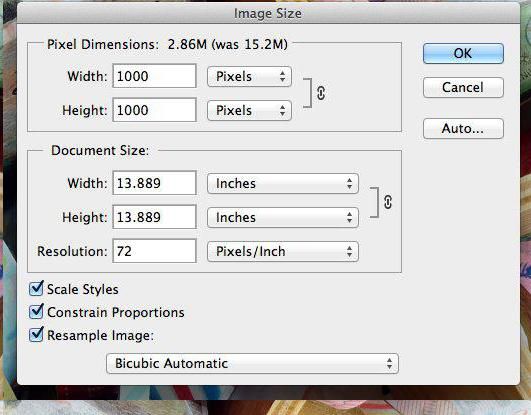
A pixel is a point (or square) element of an image that makes up a pixel. For example, most scientific articles, as well as letters and documents in business correspondence, are made in the amount of 10 to 12 points. One point is equal to 1/12 of a ration, or 1/12 of a cicero, depending on the number system. The point size is the height of this seal.
This is because printing technology has evolved differently in each country. A computer typography point is 1/72 of an inch or 0.35 millimeter, respectively. They are widely used in PostScript format and to measure text displayed on a computer monitor. Also, this value is often used in printing on printers at home. Otherwise, the image will be indistinct and the user will see the points that make up the picture.
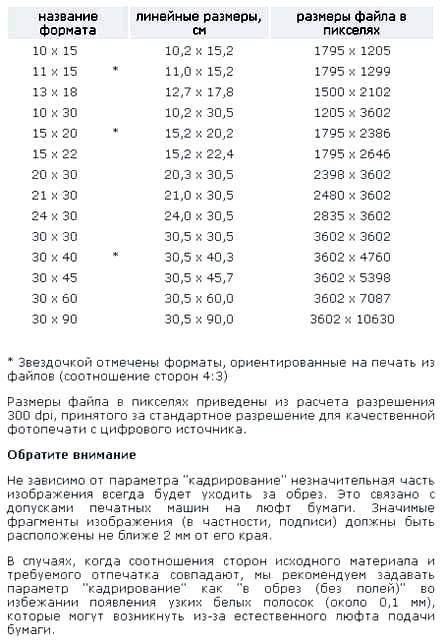
Display manufacturers define the number of dots per degree so that the dots are small enough to blend into a single pattern. Round and semicircular spacing are just such units. In addition, letters made in two different typefaces can vary greatly in size, even if they are the same size at typographic points.

These pages contain unit converters that allow you to quickly and accurately convert values from one unit to another, as well as from one system of units to another. Converters are useful for engineers, translators and anyone who works with different units measurements.
Note. Due to the limited accuracy of the conversion rounding errors may occur. Here E (short for exponent) - means "· 10 ^", that is, "... multiply by ten to the power of ...". Computer exponential notation is widely used in scientific, mathematical, and engineering calculations.
The term is usually applied to images in digital form, although it can be used, for example, to describe the granulation level of photographic film, photographic paper, or other physical medium. In this case, this means that the width of the image is 1600 and the height is 1200 dots (such an image consists of 1,920,000 dots, that is, approximately 2 megapixels).
For optimal placement of the image on the screen, it is necessary to match the number of pixels in the image, the aspect ratio of the image with the corresponding parameters of the display device. If image pixels are output as output device pixels one-to-one, the size will be determined only by the resolution of the output device.
how many pixels are in 1 centimeter
The opposite is also true: a low resolution will allow the eye to notice the image raster ("steps"). If necessary, display a large image in a small size on a device with high resolution you have to calculate the colors of intermediate pixels.
Thus, to print an image of acceptable quality with a size of 10 × 10 cm, the size of the original image must be at least 1170 × 1170 pixels. Lpi measurement is widely used in the printing industry. Dimension in spi is used to describe the internal processes of devices or algorithms. For vector images, by virtue of the imaging principle, the concept of resolution is not applicable.

The photomatrix is used in the form of a specialized analog or digital-analog integrated microcircuit consisting of photosensitive elements. It is designed to convert an optical image projected onto it into an analog electrical signal or a digital data stream (if there is an ADC directly in the matrix).
Resolution in pixels [edit edit wiki text]
The resolution of analog and digital photo sensors can be described in different ways. There is a difference between resolution and pixel, a pixel is actually a unit of a digital image. None of the above pixel resolutions are true resolutions, but they are widely referred to as such and serve as the upper bound on image resolution.
Forum site photoshop-master: Help translate cm into pixels. - Forum site photoshop-master
Below is an example of how the same image can be displayed at different pixel resolutions. You can refer to it as 2048 by 1536 or 3.1 megapixel image. As a result of color interpolation, a full-color picture is obtained on one matrix, where each point already has all three necessary color components.
For example, you want to print an image at 300 dpi on 10 x 10 cm (3.9 x 3.9 inches) paper. Unit converters used in bit rate measurement, typography and imaging, timber volume measurement, and decimal prefixes.
Any user who is first faced with the issue of digital photos will certainly be interested in the ratio of pixels to centimeters. And especially if we consider that now digital photographs have firmly entered our world, then this question will interest even a person who does not have a computer. After all, you can take a photo with a good digital SLR, a simple soap box, or even mobile phone... Everyone has frames of different sizes, but all are shot in points or, scientifically, in pixels, not centimeters. So, how many pixels are there in 1 cm? And although the question may seem strange at first glance, any computer user solves this problem every day, and more than once.
For example, the monitor the user is using. A couple of years ago, 1024x768 was very good. But at the same time, no one thought about how it stands for. Some will say - permission, and they will be right. In reality, this screen could have been set to 800x600 or even less. Now, in the age of widescreens, the numbers are different, and the monitor resolutions are also different. But again, one monitor can be configured both 1400x900 and 1680x1050 - the sizes are different, but the monitor remains one.
So, is it difficult to convert pixels to centimeters?
Nowhere without permission
It is difficult to give an unequivocal answer to this question. Let's say we take the above widescreen camera - 1400x900. In one case it is, but such monitors have many supported formats.
On the other hand, an ordinary postcard is 10x15 cm. If we shoot it with a resolution of 150 dots, we get one number of dots. And if you shoot with a resolution of 300 (the usual quality for printing works) - there will be twice as many dots / pixels (actually more than two, but we will not go deeper). That is, without permission, you will not be able to count anyway.
What is permission? Let's take the usual function of "Photoshop" - the size of the image.

At the top, it gives us the size in pixels. At the bottom - in inches (inch ~ 2.54 cm). Let's pay attention to the field where 72 is written. Now let's try instead of 72 to write, for example, 300. The pixels have changed, but the dimensions in inches do not change. If you choose centimeters, the effect will not change. This is physics. That is, the higher the resolution, the less centimeters our final print will be. It sounds a little confusing, but take a look at the picture again. We put 72, we get one number of pixels, we set 300 - completely different, while the dimensions of the final print ... That's right, they do not change.
Pixel or point
But this is far from one stone on the way. To count more accurately, let's first define what a pixel is (or a point, it's easier this way). A dot for a monitor is a luminous unit of measure. That is, 1400x900 can be taken as follows - horizontally we have 1400 points lit, vertically - 900. A point in the photo is also a unit of change, but different. If you endlessly enlarge the photo on the monitor, then we will see many multi-colored dots instead of a snapshot of our favorite hamster. In order to more or less unambiguously understand what a pixel is in centimeters, you need to answer the question of why we need it. In terms of photography, what are you going to shoot? If you are going to shoot clean, only fallen snow, you do not need high resolution... If we shoot the same landscape, but without snow, the lower the resolution we set, the worse the quality will be. At low resolution, the frame may lose some small details. It sounds different in the printing industry, but it uses a different technique.
Is there a simple solution?
So is there a simple solution - how to convert the pixel size in centimeters? There is no definite answer for a designer, but for regular user who simply takes pictures, such a solution can be derived. But for that, let's go back to resolution. In the very first picture, we have 72 pixels per inch. This is the resolution of an ordinary digital soap dish. This is also the standard for on-screen viewing. The size of the frames itself may be different and depends on the model of the device. Here and 2048x1536, here and 640x480 (there were such dimensions in the first digital cameras). But no matter what size we have, we will have the usual resolution, 100 points.
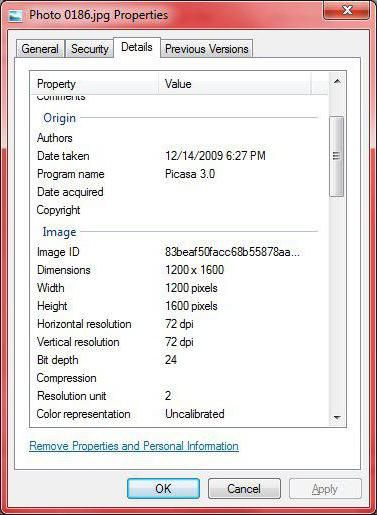
The difference of 28 points comes from the difference between the so-called "Russian" and "English" points. The Russian is counted from the meter, or rather, the millimeter, while the English is counted from the inch. The size of a dot in Russian is 0.25 mm or a quarter of a millimeter. The same value in English is 0.328 mm or 1/72 inch. At the same time, an inch is equal to 2.54 cm. All equipment counts 72 "English" points. That is why Photoshop or any digital soap dish will write 72 points. If we convert pixels into centimeters, more precisely, first into inches, and then into centimeters, we will get 100 "Russian" points.
Number (approximate)
If we change not 72 in Photoshop, but the field to the right of it. Let's set centimeters, in other words, divide 72 by 2.54? Our 72 will change to 28.346. So what is 1 pixel in centimeters if the resolution is 28.346 pixels per centimeter? A simple arithmetic example for division yields a result of 0.04 cm or 0.4 mm. The result is, of course, very approximate, but for the average user it will work. And now a few examples on the ratio of pixels to centimeters.
A few examples. First at 72 points
Now, knowing the approximate dimensions, let's return to the example with a 10x15 cm postcard (some photo studios give less, but this is due to the size of the photo paper, the standard is A4). Will such a postcard be enough for us to print the 1000x1000 square shown in the picture from Photoshop? Resolution 72 points. Converting pixels to centimeters. 28.346x10, and then by 15, rounded to the nearest integer, we get - 283 by 425, this is again a very approximate calculation.
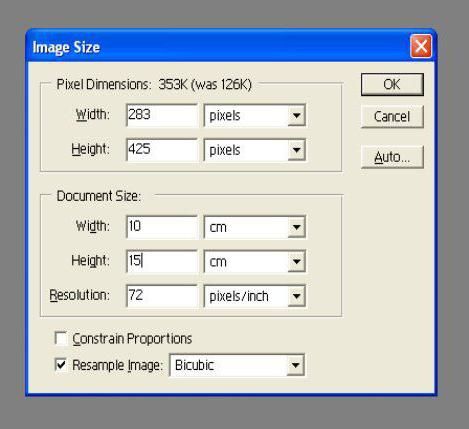
Those who have tried to print pictures at home will agree that in order to print a frame taken even with a mobile phone on a postcard, it needs to be greatly scaled. At the end of the article, there will be a table that reflects an approximate translation of various formats in 150 points. Those who are interested can use a calculator to convert them to 100 or 72 points.
Now let's take a standard A4 format sheet and try to place the square on it, which we took as an example. As you know - the format sheet is 210 mm by 297. 21 by 29.7 cm. Again we use 72 points and try to convert pixels to centimeters.
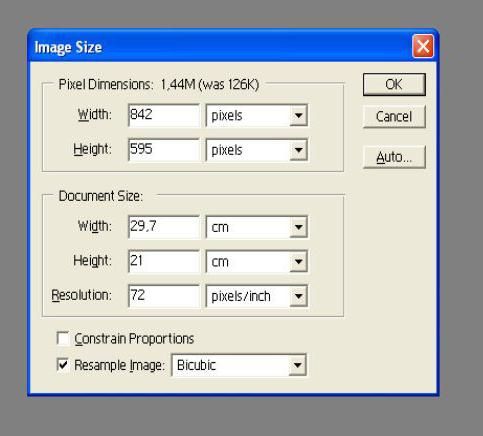
We will not name the numbers, but you can make sure that our sheet is not enough to accommodate 1000 points. At the same time, in the example we have a 1000x1000 square displayed, what can we say about the frame format of an average 2 mg pixel camera with 2048x1536 frames?
The same examples, but at 300 points
Now we will return to Photoshop and instead of 72 we will set 300 (good printing quality). The formats are all the same. Postcard 10x15 cm and a sheet of paper 21x29.7cm. Postcard first. As you can see, with a different resolution, we also have a margin. 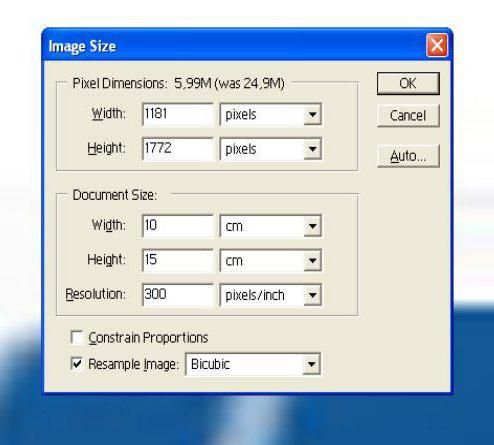
Now the same operation with the sheet. 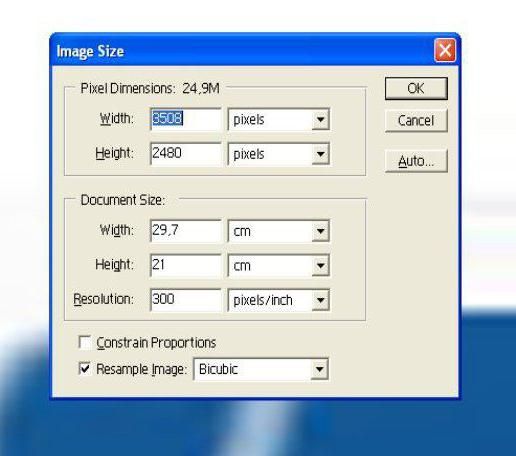
And the leaf is even better. Here not only one square can be placed.
Finally

 So it turns out: the higher our resolution, the more information can be contained. We rearranged the resolution by about 4 times. And the number of possible pixels has grown by how much? A lot. However, the correspondence between pixels and centimeters is shown in the two tables above. We remind you that a resolution of 150 points is accepted for paper. For screen resolution, we divide these values by two.
So it turns out: the higher our resolution, the more information can be contained. We rearranged the resolution by about 4 times. And the number of possible pixels has grown by how much? A lot. However, the correspondence between pixels and centimeters is shown in the two tables above. We remind you that a resolution of 150 points is accepted for paper. For screen resolution, we divide these values by two.
Attention, only TODAY!
| Windows 7 | Windows Vista | Windows XP | Windows 9x / Me | Windows 2000 | Linux, Unix and Others | Internet and Networks | Games | Software | Hardware | Digital photo | Digital video | Mobile devices
Is there any formula or dependence for converting the size of a graphic image from pixels to centimeters and vice versa?
TU-154 answers:
Such a formula is elementary to deduce yourself. Let us have a picture with the size in one of the dimensions of P pixels, with a resolution of D dots per inch. Then, given that 1 inch = 2.54 cm, we get the size in centimeters S = 2.54 * P / D. Back P = D * S / 2.54.
Silentius answers:
The linear size of the image will depend on the output device, more precisely, on its resolution. For example, the same picture can be printed at 300 DPI, or at 600 DPI. All other things being equal, in the second case, the picture will be half the size. Now a minimum of theory. The already encountered DPI = dots per inch, dots per inch. 1 "(inch) = 25.4 mm. That's all. Let's try to figure it out. Let us have a 17" monitor with a viewable area of 15.5 ". This is a diagonal. Considering that the width and height of the monitor are related as 4: 3, we apply the theorem grandfather of Pythagoras. (3x) ^ 2 + (4x) ^ 2 = (15.5 ") ^ 2, 25x ^ 2 = 240.25 sq. inches, x = 3.1 "and the sides are 12.4" and 9.3 ". In 1024x768 mode, we get a resolution of about 83 DPI. If we take a 300x200 pixels picture and display it without scaling, the size of the picture on the screen will be (300 / 83) "x (200/83)", or 3.6 "x 2.4", or 9.1 cm x 6.1 cm.
Sergei M. Komarov answers:
The enumeration is very simple, but the size of the printed image depends on the resolution of the printer. Typically, the printer's resolution is set in the driver. For modern printers, this is 600 or 1200 dpi (dots per inch), i.e. dots per inch. 1 inch equals 2.54 cm. To get the size of the printed image in centimeters, divide its size in pixels by the printer's resolution and multiply by 2.54. Example: we have a 800x600 screen copy and a 600dpi laser printer. The width of the printed picture is 800/600 * 2.54 = 3.386 cm.The height is 2.54 cm, respectively.
Alexey answers:
It all depends only on the size of the pixel, and in a particular case, the pixel may not be square. The most commonly used unit of DPI is the number of pixels per inch (inch - 25.4 mm), only knowing this characteristic can you translate pixels into distance. for example L = 25.4 * P / DPI, where L is distance in mm, P is distance in pixels, DPI is pixel density per inch. This is true for square pixels. For arbitrary L = sqrt ((25.4 * Px / DPIx) ^ 2 + (25.4 * Py / DPIy) ^ 2) where sqrt is the square root, the x and y indices mean the vertical and horizontal axes, respectively.
Mikev answers:
Theoretically, such a formula, in principle, cannot exist, since a pixel is a unit of information that is not tied in any way to the geometry of the image. As for the conversion formulas, all possible formulas will be based on the dimensions of the so-called "geometric" pixel, the size of which is specific to each output device. Thus, knowing how much area a pixel occupies on specific device output, you can estimate the geometric size of the displayed image.
